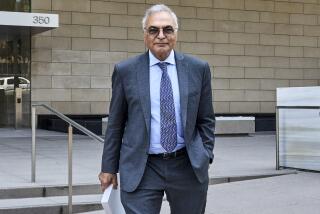Breast Implant Settlement Wins Preliminary OK : Courts: Judge sets deadlines for filing claims. He also mandates that 75% of the $3.75 billion fund be spent on women who were injured.
A record-breaking $3.75-billion class-action breast implant settlement that could provide compensation to thousands of women nationwide, including many in California, cleared its first major hurdle Monday as a federal judge tentatively approved the deal and set deadlines for filing claims.
U.S. District Judge Sam C. Pointer Jr. of Birmingham, Ala., also announced that he was taking two steps that should make the settlement more appealing to women who allege that they were injured by the implants.
Pointer appointed Ann T. Cochran of Houston, a state court judge, to serve as the claims administrator for the settlement fund. Cochran has been the coordinating judge for hundreds of breast implant cases pending in Texas. She was praised as someone âwho understands the real issues the women have to deal withâ by Sybil N. Goldrich of Beverly Hills, co-founder of the Command Trust Network, a nationwide information clearinghouse for breast implant recipients.
And in a strong effort to persuade women that the settlement fund will not be drained by excessive legal fees and other costs, Pointer decreed that at least 75% of the money will go to women with implants.
The judgeâs order on money issues puts teeth into sentiments he expressed at a March 11 hearing, when he said it was his goal to ensure that no more than 25% of the settlement pot goes for legal fees and other costs.
Representatives of several implant support groups, including some that have been critical of the settlement, praised Pointerâs action.
Ralph I. Knowles Jr., an Atlanta attorney who was co-chairman of the National Breast Implant Plaintiffsâ Coalition, called the judgeâs action unusual but wise because in cases like this there frequently is speculation that lawyers will be paid excessively.
A 75% share âis a good return if you look comparativelyâ at what happened in other mass tort cases, Knowles said.
About 1 million women received silicone gel breast implants in this country between 1962 and 1992, when the federal Food and Drug Administration restricted their use. Many of the thousands of lawsuits filed nationwide maintain that silicone leaked out of the implant pouch and migrated throughout womenâs bodies, causing numerous diseases.
The settlement contains a lengthy list of injuries for which women can be compensated, depending on their age and the severity of their injury.
Projected compensation, after reduction for administrative costs and legal fees, ranges from $105,000 to $1.4 million per person, according to the settlement notice.
Those amounts could be increased if more companies join the settlement, whose participants now include Dow Corning, Baxter Healthcare, Bristol-Myers Squibb and some smaller companies. Negotiations between 3M, Union Carbide and other companies, which could add up to $1 billion to the settlement fund, are scheduled to resume today.
âThe settlement is much more desirableâ for many reasons if 3M and the other companies participate, said Alan B. Morrison, director of Ralph Naderâs Public Citizen Litigation Group, who earlier indicated that he might challenge the deal because it was inadequately funded and did not cover all the appropriate diseases.
âIf 3M is not in the deal, there will be a lot more proof required in what was supposed to be a painless administrative procedure,â because women will have to show that their implants came from one of the settling companies, not 3M, Morrison said. He also expressed concern about whether the women will have adequate time to make a decision on whether to join the settlement or opt out.
A massive public information campaign on the settlement--including television, radio and newspaper advertisements--is scheduled to start April 18. Pointer has set up a toll-free number, (800) 887-6828, that women can call if they want information mailed to them.
In addition to a âcurrent disease fund,â which provides compensation for women who are ill, the settlement provides money for medical monitoring and removal of implants.
It also contains a mechanism for making other diseases compensable later if scientific evidence is developed showing a possible link between implants and those diseases.
The settlement does not require proof that a covered disease was caused by a breast implant.
The accord runs for 30 years and is designed to operate like an insurance policy. By signing up now, a woman who has implants could get compensation if she became ill later, said Elizabeth J. Cabraser, a San Francisco lawyer who was on the plaintiffsâ negotiating committee.
Women with saline implants also are eligible to participate in the settlement.
Pointerâs order set a schedule for key events in the massive litigation:
* June 17 is the first deadline for women who do not want to participate to file papers opting out of the settlement, thus enabling them to pursue their own lawsuits. That is also the deadline for individuals desiring to file objections to the pact.
* Aug. 18 is the date for a hearing on the fairness of the settlement.
* Sept. 16 is the deadline for women with eligible diseases to file claims for compensation.
* Dec. 1 is the deadline for women to register to make claims for medical monitoring, to have an implant removed, or to be eligible for compensation later if they develop one of the covered diseases.
The elaborate settlement still could fall apart. If it attracts more claimants than anticipated, the amounts individual women receive could be lowered. In turn, reduced payouts could prompt women to drop out. And a smaller than anticipated class of plaintiffs could be grounds for the defendant corporations to withdraw from the deal.
More to Read
Sign up for Essential California
The most important California stories and recommendations in your inbox every morning.
You may occasionally receive promotional content from the Los Angeles Times.










